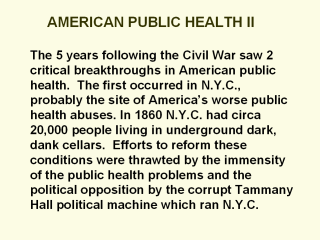 |
In December, 1863,
the Citizens' Association was formed by concerned merchants and lawyers,
later gaining medical support from leading community physicians. This
association conducted the first mayor public health survey of a big American
city in 1864. The results were startling. The report cited such occurrences
as blood and liquid animal remains running from the slaughterhouse on 39th
St. 2 blocks into the river, and that youngsters on Broadway could earn a
nickel by sweeping a path through the muck for those wishing to cross the
street. Armed with these hard facts Dr. Steven Smith went to the state
legislature in Albany, which, in 1866 passed the landmark Metropolitan
Health Bill which created the first modern city board of health in the
United States, relatively free from political interference. By 1890, 292 Am.
cities of over 10,000 population had a board of health patterned after the
N.Y.C. model. |
